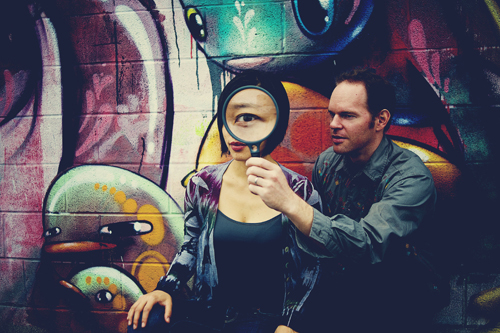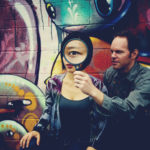I didn’t know the piano and toy piano were hybrid percussion instruments until I encountered the talented toy pianist and percussionist Phyllis Chen. Watching Phyllis perform “Double Helix” where she plays a toy piano with her right hand and ‘drums’ metal bowls with a mallet in her left was an entrancing experience. Classically trained as a pianist and composer, Chen finds the percussive and timbral elements in common, everyday objects. She started UnCaged Toy Piano, a competition for toy piano and electronics and released albums composed for toy piano and was the featured solo musician in Stephen Merritt’s Coraline. She collaborates with video artist and electronic musician Rob Dietz on multimedia works like this weekend’s Looking Glass ReWondered, composed of Down the Rabbit Hole and The Memorist. In true Phyllis style, toy piano, puppets and a sampling keyboard whose notes are made of recorded kitchen utensil sounds are all incorporated in this Alice in Wonderland inspired piece.
– By Cathy Hsiao
All photos by Kimono Photography
Full name: Phyllis Chen
Age: 32
Where do you live now: New York
Musicians currently collaborating with: Rob Dietz, CUNY City Tech’s Department of Entertainment Technology
Musicians collaborated with in the past: Stephen Merritt, Proper Glue Percussion Duo
TTM: Can you tell us about your background as a pianist and how you became interested in unconventional sound generating objects, the toy piano one among many?
PC: I started playing classical piano at the age of five. I spent a good part of my adult life exploring possibilities on the piano with extended techniques and sticking foreign objects in the piano. When I was 21 I came across a toy piano in the basement of a puppet parlor in Chicago. I touched it and fell in love. I fell in love with its imperfect tuning and its elusive timbre. Now that I am composing for more traditional and non-traditional instruments, I find that my point of inspiration is the natural acoustic sound of the instrument/object. The sound itself seems to tell a story, and the toy piano story seemed unexplored.
TTM: How do you compose the percussive element of your pieces?
PC: My pieces start with a timbral image or vision. I find myself gravitating towards writing my percussive lines first because I am trying to map out the momentum of the lines, the kind of energy and pace of the piece by doing this. Many of the instruments that I use percussively have a complex timbre that makes it difficult to define a clear pitch. Generally, I feel very hindered by pitch, so writing rhythmic lines with contours seems to leave me a lot of room.
Listen to Mesmers.
TTM: In the video of your performance “Double Helix” it looks like you’re playing as two people in perfect orchestration. Amazing! How do you maintain such rhythmic coordination?
PC: Thanks! Though the toy piano part is virtuosic, I am used to playing the keyboard with my eyes closed. For this piece, my focus is really on playing the bowls while my right hand is coasting on my familiarity with the topography of the toy piano. The bowls do need to be placed in a certain way. I usually compose next to a toy piano so the physical experience of improvising and playing seems to dictate a certain level of the composition. With “Double Helix,” I had an idea in mind and knew what instruments/bowls I wanted to use. One day I had a watershed moment and wrote out the entire thing in a notebook. I told myself that I would play what I wrote, even though it was written away from a keyboard.
TTM: Can you elaborate your interest in “mysterious objects that become musical through unexpected manipulations”? How do you record tea – balls and forks? Contact mics?
PC: As a composer, I’m drawn to miniature objects and found sound-making devices. For The Memorist, I use an amplified resonating space (toy piano) that picks up the sound of forks, spoons, tea set, door slam, poker cards through a contact microphone. As these sounds go through the microphone, I record/process them live during the performance. I use recorded samples of a tea-ball, pan lids and mixing bowls on my keyboard sampler that I play alongside the toy piano. These sounds are pitched, idiosyncratic and surprisingly complex! I spent four hours with a couple of my collaborators analyzing the many pitches that exist in my collection of 19 mixing bowls. The idea of making something very small, intimate, subtle and nearly inaudible into an inviting space is very engaging and mysterious to me. I think commonplace objects can act like a trigger to us. It reminds me of what Picasso said about masks. It’s not about the mask itself, but the mask serves as a trigger to another kind of experience.
TTM: Is it accurate to say that creating and evoking musicality in places and things where there were none before seem to be a major goal of your music – playing?
PC: The toy piano was also a found object…it was brought to my attention as a set piece, not as a music-making device. The fact that the toy piano is called a “toy” brought up questions on how musical can a “toy” be? When you think about toys from other cultures and other times, you realize many toys are found objects. I’ve noticed a similar approach to percussion set-ups. From off-stage, percussionists always look like the one’s playing the most toys.
TTM: Is timbre something that motivates your compositions? How does what kinds of timbre you want to get resonate or interact with the percussive in your pieces, for example the toy piano with the sampling keyboard in The Memorist?
PC: Timbre is generally where I begin compositionally. In The Memoirist, the sampling keyboard acts as a kind of punctuation to the toy piano line. Generally, pitch is hard to define on the toy piano, which has been liberating for me. Toy piano is generally experienced as a percussive instrument with a specific timbre. I find this to be very inviting to another kind of music-making…one that is less pitch-driven, but more timbre and rhythm driven.
TTM: Do you ever play a ‘traditional’ drum kit or compose for one?
PC: I haven’t, but am very interested!!
TTM: Last, piano and toy piano: string or percussion instruments?
PC: I have always thought percussive—unless I’m bowing it.
TTM: Thanks Phyllis!!



